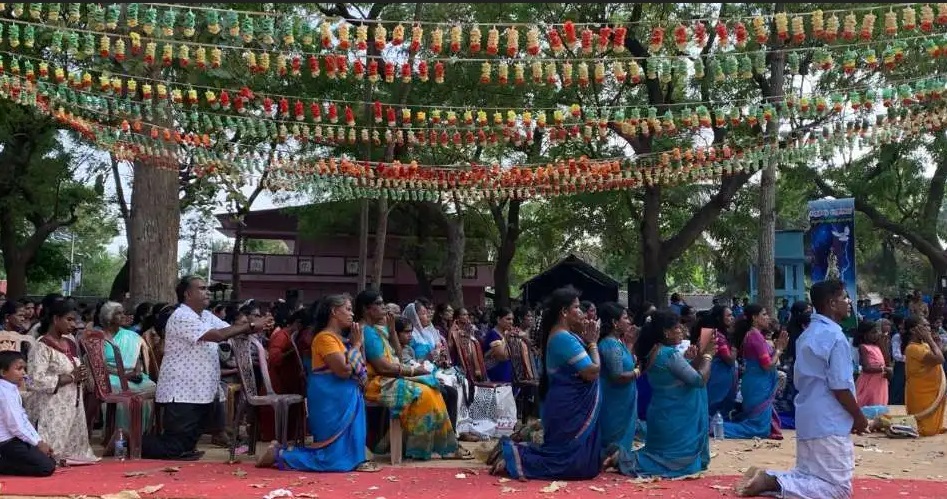Sri Lankan shrine stands tall despite Dutch persecution and civil war
When P. Lilly Mary joined the golden jubilee procession of the statue of Our Lady of Madhu in 1974, Sri Lanka’s northern areas had not yet descended into a bloody ethnic civil war.
Apr 18, 2024

By Rubatheesan Sandran
When P. Lilly Mary joined the golden jubilee procession of the statue of Our Lady of Madhu in 1974, Sri Lanka’s northern areas had not yet descended into a bloody ethnic civil war.
Fifty years later, Mary returned to her St. Mary’s Parish Church, some seven kilometers from Jaffna, to witness the centenary procession of the blessed statue of the Virgin Mary holding baby Jesus.
The iconic statue was coming to the Jaffna area for the first time since government forces suppressed a three-decade-long civil war (1983-2009) led by the Liberation Tigers of Tamil Eelam, seeking a separate homeland for Tamil-speaking people.
The procession and festivities mark the centenary of the coronation of the statue of Our Lady of Madhu in 1924 after Pope Benedict XV issued a decree of pontifical coronation on April 7, 1921.
The decree is a formal papal act that recognizes the popular piety of honoring an image and gives the image the right to wear a crown or halo. In effect, the act recognized the unique local piety of Sri Lankan people, honoring the Marian statue.
As part of the celebrations, the statue is taken on procession throughout the Jaffna diocese, including northern areas, from April 4 to 30. The statue, carried in a motor vehicle fashioned as a chariot, is scheduled to visit all deaneries in Kilinochchi, Mullaitivu, Point Pedro, and the northern islands.
Mary said the statue coming to her parish was “a great opportunity for folks like us who are unable to go on annual pilgrimages as we used to due to our age now.”
The procession's paths are decorated with Marian blue and white ribbons. Parishioners also place kumpams (coconuts placed on pots), which follow the Tamil custom of welcoming the statue to their respective parishes.
Jaffna was intermittently under government and rebel control. Many churches in the nation’s northern tip were destroyed or abandoned. With many of its priests and religious killed or disappeared during the war, the diocese is still reeling under a shortage of manpower to help people rebuild lives.
However, at the height of the conflict, the 400-year-old shrine in Jaffna diocese became a symbol of unity between the warring Tamil and Sinhalese groups. Situated in the heart of the conflict zone, the shrine was shelled several times and had to house refugee camps.
The shrine was set up during the Dutch persecution in the 17th century. Nearly 20 Catholics who escaped the persecution erected the shrine with the statue in a jungle. Later, Oratorian missionary St. Joseph Vaz from India, and other Oratorian priests expanded it further.
During the civil war, the diocese relocated the statue to the nearby St. Xavier parish for safety. In August 2008, the statue was brought back and the shrine was declared a peace zone at the request of former Bishop Rayappu Joseph of Jaffna.
“Our Lady of Madhu has been a ray of hope throughout history, from Dutch persecution in the 17th century to recent wartime years. She blesses all irrespective of their religion or ethnicity,” said Father Anthonypillai Gnanapragasam, the shrine’s administrator.
In 2001, the statue’s procession was extended to southern Anuradhapura, Galle, and Colombo dioceses as the civil war temporarily halted following a ceasefire agreement.
Ahead of the centenary procession to Mary’s parish in Koay village, “many Hindus joined locals to assist, and many came to witness,” said Father Louis Montfort, its parish priest.
Montfort said Our Lady of Madhu has many Hindu devotees, who prefer to call her Puthumai Maatha, named after a Tamil saying.
Amalathaas Rosequil, 64, was one of the Hindus who joined the procession. She said she became a Marian devotee after she overcame a health issue.
At 26, she said, she met with an accident and doctors feared she could lose her eyesight. “I prayed to Puthumai Maatha. Eventually, my eye was healed,” Rosequil told UCA News.
“Not only myself, Puthumai Maatha blessed many of my relatives as well,” she said.
The shrine's annual festival is held on Aug. 15, when the historic church in the war-torn area attracts thousands of visitors.--ucanews.com







Total Comments:0